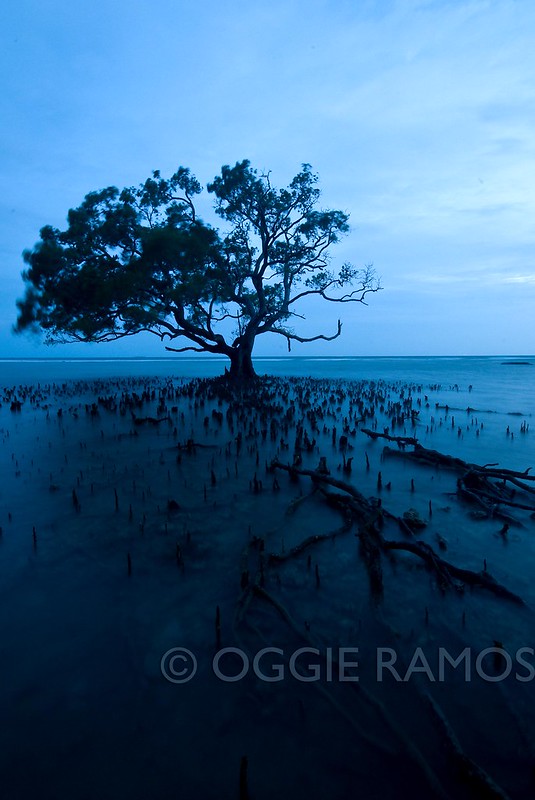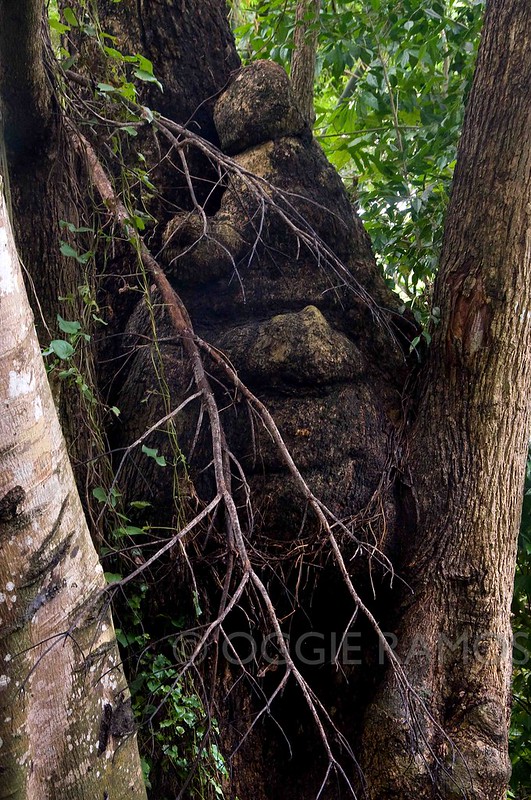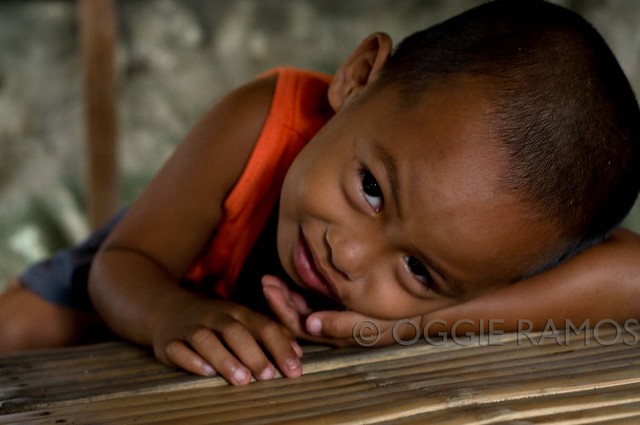 |
| The western coast of Inampulugan is fringed by mangroves |
When we had an alfresco lunch by the beach in Nagarao, the tide was low and the water smooth under an increasingly grey sky. By the time we left for Inampulugan, the sea was already wearing a dark shade of green and the waves were gaining white caps. What usually takes 25-30 minutes to sail took us almost an hour to navigate.
Mang Vic, a trim man in his fifties with an infectious smile that belie his stature as the island’s father figure, was patiently waiting for us at the alternate port on
the northern side of Inampulugan. Five years of managing the affairs of this 137 hectare island has not slowed him down one bit, eager to welcome each new arrival like a family member. "We were worried about you,” says Manny, one of Vic’s staff. If I haven’t previously sailed in much turbulent conditions in these parts, I would also be worried.
 |
| Rustic, airy cottages by the Bamboo Beach |
The choppy ride aside, our roundabout approach near the coastlines gave us a sweeping look at Inampulugan, with its vegetation-covered hills that taper off to lush
mangroves, an eyecatching palette of dark and light shades of green that the
somber sky could not diminish.
Traversing the island via motorized tram, the sight of so many coconut trees added to the tropical feel. We passed through the local village, population: 328 and counting, and I didn’t get the feeling of desolation I felt in Nagarao. Coming over to the southern side, the roar of the sea greeted our team as we stepped onto Bamboo Beach.
We were billeted at one of the 10 beachfront cottages less than a hundred steps away from the shoreline where a patch of fair sand overlooks the boulder breakwater. The cottage, like the other structures, is built from bamboo, wood and grass like an organic tapestry that blends with the bamboo thickets growing profusely around the
resort.
Power comes on twice a day, from 11:30am to 1:30pm and 5:30pm to 6:30am, but I didn’t really mind. It was breezy from where I sit on the porch. Our cottage even had an air
conditioner but we opted to go au naturel, letting the sea breezes flow freely
through the big windows.
Shooting on the rocky fringes of the beach on our first afternoon, I got caught in two squalls that came and went with little warning. Such was the fickleness of the weather but standing there on the rocks being pounded by the waves and soaked by the downpour, it was a rather edifying finding myself immersed the experience instead of merely being a spectator of the forces of nature at work.
Waking up early the next day, the weather didn’t look promising but our team pressed on, spending the early part of the morning kibitzing with the villagers with Mang
Vic. The local community, three generations of workers who settled, married and took root here, is self-reliant, thanks to the bounty of the island. While the waters abound with fishes, the bigger industry is in coconut. At its peak, the village men was churning out 30 tons of copra every month. Aside from weaving bags from grass, the women make organic soap from coconut. Used in the resort, the soap has found a steady market among Korean guests who have taken a liking to the natural product.
Over one of our meals, I was enamored by the prospect of hiking up the hills to the viewdeck, the highest point of the island for a panoramic view of the nearby land
masses. But the constant rains meant slippery trails better reserved for hiking come summer. The farthest we ventured was a trip to the mangrove areas where decades-old trees can be found. A turtle pond lies adjacent to it where Mang Vic displayed his magic, summoning two of the Hawksbill Turtles as if by will to the surface. Either he’s
the turtle-whisperer or the turtles have become accustomed to five years of seeing him.
Nearer to the village, we had a cursory look at the Pill Box, the remnants of the Japanese military armory during the last world war.
On our second afternoon on the island, I was tempted to kayak within the confines of the breakwater. Dissuaded by the big waves, I settled for horsing around, literally, on the beach, riding one of the island’s four horses. The weather fouled up again by late afternoon. Passing by the beach during the bout of wind and rain, the towering
bamboos sway and creak as if singing, defiant of the constant gusts.
After spending a lackadaisical sunset at the mangrove areas, we headed back to the Coconut Pavilion for dinner. The spacious area could easily host over two hundred guests but apart from a small group of missionaries from Iloilo, we had the place to ourselves. The lone TV in all of the resort blares its dose of sensational news and tepid telenovelas but we were more interested in enjoying our meals (we even had a taste of the quintessential Guimarasnon dish, Binakol – chicken simmered in coco water right inside the coconut husk and slow-cooked over hot coals), enjoying a serving or two of the wonderful homemade coconut ice cream and sharing banter over brewed coffee.
Isn’t it lonely staying on the island, I asked Mang Vic. His quick answer: “not when
you have the whole village as your family”. I guess having a bigger island and more people to share it with is less conducive to developing homesickness. The more regaling stories he shared are the most elusive. Mang Vic tells us of old
trees in the primary forests so thick, it takes 10 men to form a circle around
them. Deep in the vegetation about an hour hike up, wild deer and monkeys still roam and wild birds roost in the hardwood trees. But with the monsoon making the trail treacherous, the path to the forest is off-limits for the time being. Mang Vic, who has
spent five years here, has been to all parts of the island many times over. As
if teasing, he isn’t saying much apart from describing the highest points of
the island as breathtakingly-beautiful – both an enticement and invitation for
us to come back, hopefully soon.
The temperamental weather continued the next day when we set out for San Isidro
wharf on the Guimaras mainland. In lieu of an island-hop, we can only get a glimpse of Us-Usan Island west of Inampulugan, cajoling us to make a brief stop with its pocket of white sand beach on one end and a long stretch of sloping terrain of inland forest. Deserted save for a single family living there, it’s one of the stops in the island hop tour in these parts. Mental note to myself: another must-visit island in the summer months.
This article appeared in edited form in the December 2012 - January 2013 issue of Inflight Magazine. To read Part 1 of this Guimaras feature, click this link.
Info: Costa Aguada Island Resort is located on Inampulugan Island, southwest of the eastern coast of the Guimaras mainland, around 30-45 minutes by boat from San Isidro or Sabang. Non-airconditioned cottages start at US$33+; airconditioned cottages at US$50+ up • Outdoor recreation such as horseback riding and climbing available. Inampulugan is a jump-off to an island hop tour of the islands of Us-Usan, Nagarao, Nauway and Natunga. To book, call Tel. 476-1761; Mobile: 0918.9241237, 0917.309942 • Manila Sales Office: (632) 8965422; 7523688; Email: [email protected]; Visit www.costaaguadaresort.com


